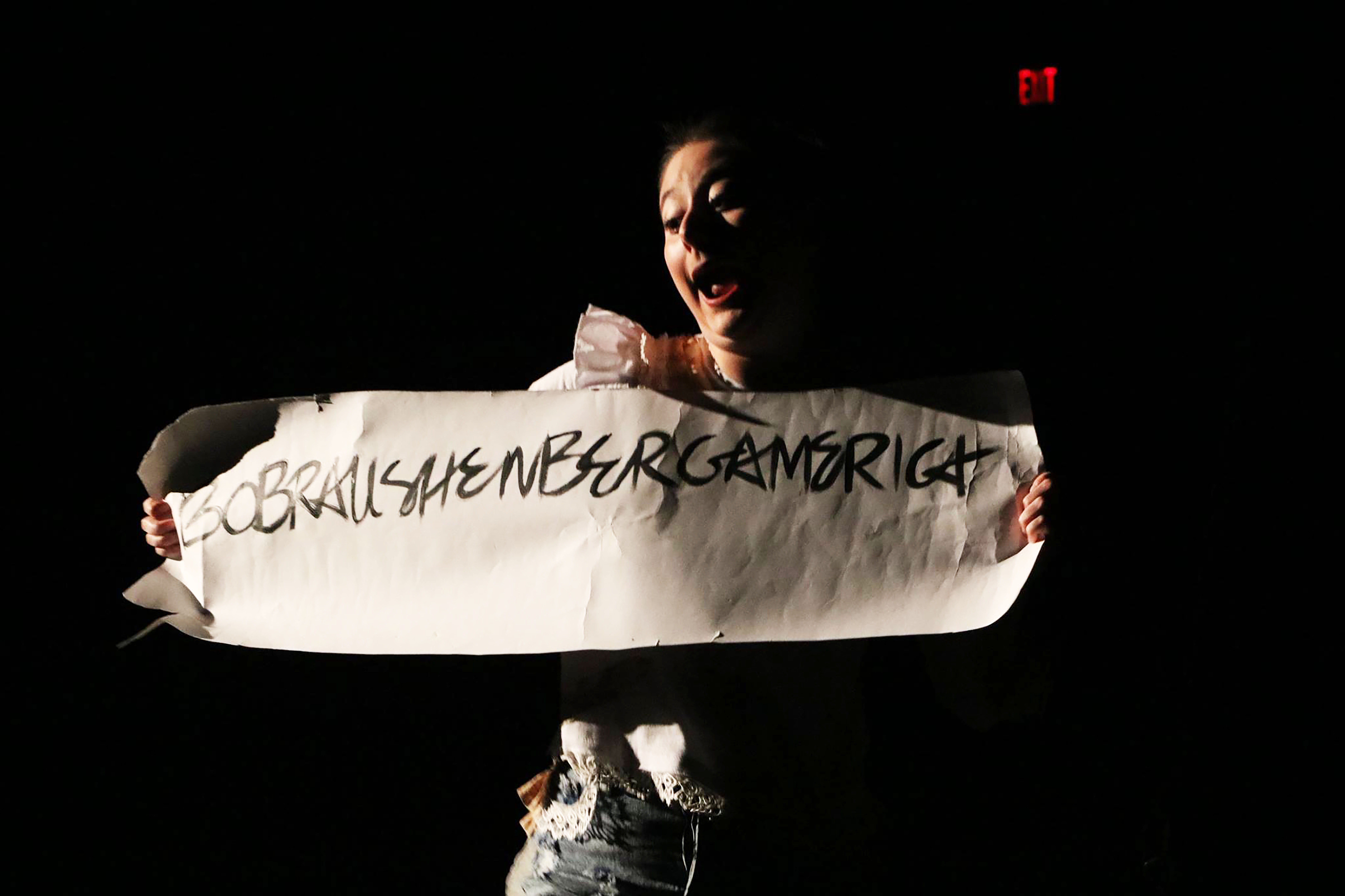Perhaps the overall confusing and zany nature of the Theater Department’s production of bobrauschenbergamerica can be summarized through one statement: Katie Soricelli ’18 probably stole the show playing a chicken (and later pizza delivery boy). Soricelli’s avian antics included a well-crafted and consistent chicken walk and voice, which she employed while regularly taking offense to the script’s occasional chicken jokes. In a particularly memorable moment during a picnic scene, she took a beat too long before realizing she was eating fried chicken, resulting in an extreme emotional outburst. The chicken character, is hinted at but not explicitly mentioned in the original script of Charles Mee’s 2001 play, reflects the overall crazy atmosphere of both the production and the play itself. This is unsurprising, given that bobrauschenbergamerica—whose Conn rendition premiered the weekend before Thanksgiving and was directed by Kimberly Senior ’95, an alumna with several prominent directing credits including Ayad Akhtar’s Disgraced on Broadway—is a work that attempts to create a play as the American artist Robert Rauschenberg would have had he instead been a playwright.
Rauschenberg became prominent in the 1950s as a precursor to the pop art movement, and his art is well known for its incorporation of found objects. The play reflects this aesthetic through scenes and scenery that reference or are in the vein of the artist’s work. Aidan Gorrell ’18 as Phil the Trucker enjoys soliloquizing from his bathtub, making reference to Rauschenberg’s “Sor Aqua (Venetian),” a piece that itself prominently features a bathtub.
Conn’s production of bobrauschenbergamerica took liberties by adapting Mee’s original text however they saw fit. This is in keeping with Mee’s philosophy of playwriting and performance rights, described on his website as “the (re)making project.” Mee feels that because his plays have borrowed from the work of others (a tradition he traces through the work of all playwrights) his plays too should be remixed and derived from. To that effect, while retaining some control over his performance rights, he has made all of his work available on the internet, and invites visitors to read and borrow from them. This manifests itself in ways such as the eschewing of stage directions like “A 123-piece local high school marching band (or else a solo bagpipe player) enters playing,” in favor of an ensemble made up of the performers, including Gorrell on flugelhorn and Ana Reyes-Rosado ’20, Bob’s Mom, on saxophone. In essence Mee’s beliefs enable the performers to adapt the work for themselves rather than the ensemble that Mee originally wrote for.

At times the piece feels more like contemporary art than contemporary theater. This is especially apparent in the way it introduces its more than 40 scenes: at the beginning of each scene a title displayed on a screen creating a gallery-like effect. There are also scenes that feel like they belong on an audio guide for an art show. Several of these scenes focus on Reyes-Rosado who sweetly delivers monologues of questionable veracity about the artist’s life and childhood. However, it’s only her very last line that was allegedly spoken by her real-life counterpart. The most literal example of the production’s likeness to a contemporary art gallery comes in the middle of the play when Charlie Gold ’18 as Carl, is reincarnated after being assassinated two scenes earlier. He immediately begins delivering a revealing speech welcoming everyone to an art show opening although he realizes by the end that his ramblings offer no real conclusion; this is a moment that feels like it would have made the play more understandable had it appeared much earlier in the script.
The play focuses much more on ensembles than individual performances. Dance is especially prominent at several moments, but there are many moments when everyone suddenly rushes on stage to gather, gossip or just go about their lives. In many scenes characters stand in the background performing their routines; for example, Claire Peyton ’21 who gave an excellent portrayal of Phil’s Girl, often makes shadowy appearances on a tire swing or sometimes in the bathtub with Gorrell. There’s plenty of spectacle too with scenes such as the aforementioned assassination, Mark McPhillips ’20 as Allen destroying a trash can with a baseball bat or Peyton setting up a martini slip and slide using gin and olives, which most of the characters slide on while Reyes-Rosado holds up ratings of their attempts.
Through its assorted vignettes, scenes and works of art bobrauschenbergamerica tries to present a picture of America as seen through the eyes of its namesake artist. Given the nature of Rauschenberg and the play’s presentation of random vignettes representing ordinary and extraordinary America, it’s easy for viewers’ opinions about it to vary. This fact makes it particularly difficult to pass satisfactory judgment on the play. My opinion is that the piece ultimately falls flat. While the cast certainly presented excellent and passionate performances, the complexity and randomness of the work itself made it difficult to parse in one sitting.









